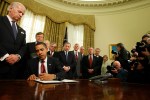Right as the Occupy movement was taking off, a popular chart highlighted the gap between the average CEO’s pay and the average worker’s pay.
Videos by Rare
According to this image, the average CEO in the U.S. earned 475 times the average worker, while the gaps were a mere 15:1, 12:1, and 11:1 in France, Germany, and Japan respectively. PolitiFact decided to give the claim a look, and cited one study that pegged the ratio at 325:1, and another which put it at 185:1.
While PolitiFact rated this claim “false,” CEO pay in the U.S. still appears ridiculously high relative to other nations. It hardly defeats the argument the chart was trying to make that its creators overstated their case.
The high CEO-to-worker pay gap is a recent phenomenon, and the causes are still debated. One explanation that I found fascinating comes from behavioral economist Dan Ariely. In his book “Predictably Irrational” Ariely notes that the rise in CEO pay coincides with regulations that went into effect in 1993 which forced companies to disclose pay and compensation of their top executives. The intentions of these regulations were to make it harder for CEOs to “get away with” outrageous pay, so to speak.
But there are intentions and there is reality. Ariely explains, “once salaries became public information, the media regularly ran special stories ranking CEO by pay. Rather than surprising the executive perks, the publicity had CEOs in America comparing their pay with that of everyone else. In response, executive salaries skyrocketed.”
In other words, all disclosing CEO pay did was create the equivalent of a high scores list for CEOs to compete on.
Is the CEO to worker pay gap defensible? Economist Walter Williams makes the point that while people get up in arms over CEO pay, we seldom see the same over the pay of celebrities. The top ten celebrities earn an average annual salary of $100 million, while the top ten CEOs earn $43 million. Perhaps one rebuttal that could be made to Williams is that while celebrities are literally paid for performance, there’s conflicting evidence as to whether CEO’s are.
For most of my time as a student of economics, I’ve defended CEO pay at its currently high levels because it wasn’t high enough to truly be considered at the expense of workers.
Let’s take McDonald’s as an example. According to the Christian Science Monitor in 2012, McDonald’s had the highest gap between CEO pay and worker pay in the nation (though some other sources grant JC Penny with this title), with CEO Donald Thompson earning 1,196 times what the average worker earns. Thompson earns $9,247 an hour — compared to $7.73 for the average McDonald’s employee. In 2012, Thompson was compensated $13.8 million for his role as CEO.
So is it fair that Thompson earns in a single year that a McDonald’s employee would have to work nearly 900 years to earn? The answer certainly would be yes if Thompson could simply solve this problem by paying himself less, but that wouldn’t do much. McDonalds employs roughly 440,000 people (full time + part time). Even if Thompson decided to work pro bono and distribute his annual compensation among his workers, this would only translate to a $31.36 a year raise per employee – or less than a 1 cent an hour raise.
Despite everything outlined thus far, there exists a gaping flaw in the statistic that the average CEO earns 300 or so times more than the average worker. The statistic tossed around isn’t exactly measuring the pay gap between the average CEO and the average worker, it’s measuring the pay gap between the average worker and a CEO at the nation’s largest companies.
Look at the AFL-CEO’s report that the average CEO earned 331 times the average worker in 2012, and you’ll see a footnote which explains that this is an “AFL-CIO analysis of 350 available companies in the S&P 500.” When the Economic Policy Institute states that “Average CEO compensation was $14.1 million in 2012,” it adds the caveat, “using a measure of CEO pay that covers CEOs of the top 350 firms.”
I happened to notice a convenient correlation that the more liberal leaning a website was, the more likely it was to omit the fact that compensation was only measured among 350 companies in the S&P500.
How do you accurately measure “average CEO pay” by looking at the top 350 CEOs when there exist hundreds of thousands of CEOs in America? Below is listed miscellaneous statistics I’ve found on CEO pay nationwide.
- The Bureau of Labor Statistics places the mean annual Chief Executive wage at $178,400, and the median at $171,610. Both estimates exclude benefits
- Forbes states that 2% of CEOs in America have an annual salary above $3 million (excluding benefits), while 77% earn $500,000 or less.
- A table in a study published in the Oxford Review of Economic Policy shows that in 2002, while CEO compensation averaged $10.3 million in S&P500 companies, it falls to $4.7 million in Mid-Cap 400 companies, and to $2.2 million in Small-Cap 600 companies.
- Companies in the “Mid-Cap 400” category have market capitalizations from $1.2 billion to $5.1 billion, while small-cap 600 companies have market caps of $350 million to $1.6 billion. This confirms that high CEO compensation is concentrated among the nation’s largest firms, and falls drastically when we look at smaller firms.
- Salary.com estimates median CEO compensation (salary + benefits + bonus) at $1,335,148. Without benefits of bonus, median CEO pay is estimated at $738,533.
Note that the government’s official statistics on CEO pay from the BLS contradict the estimate from Salary.com. However, with per capita income in the U.S. above $50,000, the CEO to worker pay gap in either case is far from the “300:1” claim. Using the BLS’s estimate, orthodontists out earn CEOs in America. Using Salary.com’s data, the median CEO’s compensation is roughly 26 times higher than the average worker (as per-capita income was $51,749 in 2012).
Regardless of which estimate you take as gospel, the main point still remains. The alleged CEO-to-worker pay gap is a misleading and thus meaningless statistic, measuring only CEOs of America’s top companies against the average American worker.



